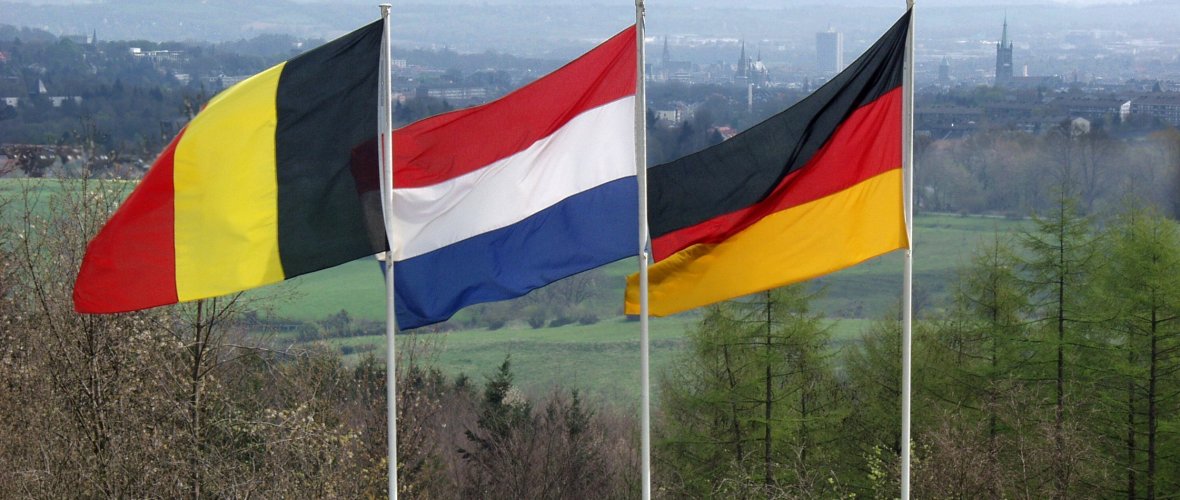Euregio Meuse-Rhine
Alongside the Dutch cities of Maastricht and Heerlen and the Belgian cities of Liège and Hasselt, the German city of Aachen is one of the main centers of the cross-border Euregio Meuse-Rhine. This unites five partner regions in the border triangle of the Netherlands, Belgium and Germany on an area of almost 11,000 square kilometers and with 3.7 million inhabitants - the Regio Aachen, part of the Dutch province of Limburg, the two Belgian provinces of Limburg and Liège and the German-speaking community of Belgium.

Location
The Euregio Meuse-Rhine enjoys an extremely favorable geographical location at the crossroads of the major economic and industrial centers in northwestern Europe (Paris, Luxembourg, Brussels, the German Ruhr region, the Dutch Randstad and the Flemish cities). The major seaports of Antwerp and Rotterdam are not far away and the regional airports of Liège Airport and Maastricht-Aachen Airport as well as the international airports of Düsseldorf, Cologne, Amsterdam and Brussels are in the immediate vicinity. The Euregio Meuse-Rhine is also connected to the European inland waterway freight transport network via the Albert Canal and the Juliana Canal/Meuse. The connection to the rail network is excellent both in a north-south direction and in a west-east direction. The European high-speed TGV train stops in Liège and Aachen.
Economy
This exceptional location is a great advantage for companies. A study showed that two thirds of the business parks in the Euregio Meuse-Rhine are easily or very easily accessible. Incidentally, more than 16,000 hectares have been set aside for companies in recent years. The Euregio Meuse-Rhine also has two research parks, two business and innovation parks and 26 business centers based on cutting-edge technology and the development of the service sector.
Training and research
The Euregio Meuse-Rhine also has assets in the areas of education and research. Almost 100,000 students attend the five universities (Rheinisch-Westfälisch Technnische Hochschule Aachen, Université de Liège, Maastricht University, Limburgs Universitair Centrum Diepenbeek, Open Universiteit Heerlen), the numerous universities of applied sciences, research centers and university hospitals, which strongly complement each other.
History
The Euregio Meuse-Rhine was founded in 1974. During an official visit to the city of Maastricht, the future Queen of the Netherlands, Princess Beatrix, suggested that cross-border cooperation between the regions, which had been so lively in the past, should be promoted as a priority. The governors of the Belgian provinces of Limburg and Liège, the Commissioner of the Queen of the Dutch province of Limburg and the President of the Government of Cologne then decided to establish a working group to intensify this cooperation. Two years later, an agreement in principle was concluded. In 1992, the German-speaking Community of Belgium joined the consortium as the fifth partner region and a fully-fledged part of the Province of Liège. Since 1991, the Euregio Meuse-Rhine has had a legal basis in the form of a "Stichting" under Dutch law. This "Stichting", based in Maastricht, coordinates cross-border cooperation between the five partner regions.
Activities
The Euregio Meuse-Rhine is currently active in eleven areas: economic cooperation, cultural events, language projects, tourist packages and sporting events, civil protection and youth work, educational projects, technology transfer, healthcare and environmental projects. The beneficiaries of this Euregional cooperation are the people who live in the Euregio-Meuse-Rhine area and who, thanks to the cross-border cooperation of the five partner regions, can increasingly assert their claims to equal living conditions in the new Europe of the regions. The focus is on the active participation of citizens in cross-border work - based on the shared conviction that dialog between neighbouring regions, which are separated solely by borders but face the same problems, can and will contribute to European cooperation and integration.